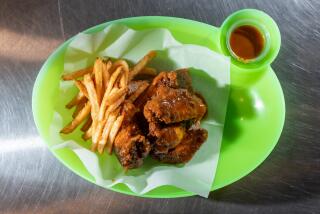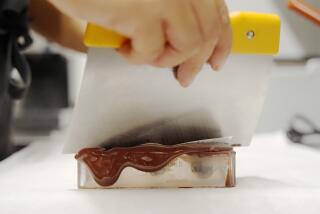Saucy Chocolate
- Share via
Most dessert sauces are well-mannered bit players that are happy going through life doing little but pointing out how delicious everything else around them is.
What could be more innocuous than creme Anglaise, for example? And though a raspberry puree is delicious, it is mainly there to complement the chocolate.
Not fudge sauces. They’re the scenery-chomping hams of the dessert sauce world. Fudge sauces are not meant to sit idly by, awaiting their moment in the sun. They stomp on stage accompanied by the blaring of trumpets and the beating of drums. They dance around, waving their arms and shouting “Look at me!”
As if it were even remotely possible to miss them. A good fudge sauce is voluptuous, thick and creamy, and even slightly sticky. The flavor is a raucous combination of dark chocolate and sometimes slightly bitter cocoa, with a liberal dousing of vanilla extract--or even Cognac--behind the ear for good measure.
Subtle they ain’t. On the other hand, why would you ever think about putting something subtle on a banana split?
At the same time, it would be a mistake to confuse their brashness with simplicity. Because their flavor lacks delicacy doesn’t mean the same is true for their preparation. A fudge sauce can be a tricky thing to put together.
That trickiness lies at the very heart of its existence. While it’s fairly simple to make a chocolate sauce--melt chocolate in heated cream, a kind of thin ganache, actually--giving that sauce the thick, rich texture of fudge takes some doing.
As does getting it to keep that texture once it’s poured over freezing-cold ice cream. If you’ve tried that with a regular chocolate sauce, you’ve found that the chocolate tends to seize up, either forming a hard shell on the ice cream or, even worse, separating out into waxy little bits.
Why doesn’t this happen with fudge sauce? Because the chocolate is bound up with corn syrup. While most sugars begin as crystals and are extremely anxious to revert to that form, corn syrup is a complex combination of various sugars and carbohydrates in a viscous solution. It’s very nature inhibits crystallization, even when regular crystalline sugar is added to it.
To explore what all that means in practice, I made almost a dozen fudge sauces from various cookbooks. Of those, there were four I really liked. The ones from master baker Nick Malgieri’s new book, “Chocolate” (HarperCollins, out in October), and Nancy Silverton’s old book “Desserts” (Harper & Row, 1986) had good flavor, but to my taste were too rich and sticky, even for fudge sauces. Too much corn syrup in both. I want a fudge sauce that has body but doesn’t coat your mouth.
Much closer was ever-reliable Helen Witty’s fudge sauce from “Fancy Pantry” (Workman, 1986). Its flavor is pure nostalgia--it tastes just like really good brownie batter. The texture was better--it coated without feeling sticky--but it was a bit grainy.
At first, I thought I had found the perfect fudge sauce in Rose Levy Beranbaum’s “The Cake Bible” (William Morrow, 1988). It had it all, a seductively smooth texture, a complex chocolate flavor and a delicate aftertaste of butter.
Unfortunately, that delicacy was its undoing when I tasted it on vanilla ice cream. Though it would have been perfect served beside some kind of pastry, on ice cream the chocolate flavor lacked the edge it needed to compete with the other flavors.
My dilemma was that though I could see the potential in both Witty’s and Beranbaum’s sauces, they are entirely different. Witty’s is pure innocence, a taste straight from childhood (well, actually it hasn’t been all that long since I licked out a brownie bowl). Beranbaum’s is about as sophisticated as a fudge sauce can be. It’s high-fashion fudge.
It was a real Mary Ann and Ginger thing, if you know what I mean. It was impossible to pick what I liked from one and combine it with the other, because doing that would have undercut the best qualities of both of them. Instead, I decided to fine-tune them, making each more like what I thought it should be.
To improve the texture in the Witty recipe, I increased the ratio of corn syrup to sugar. Though too much corn syrup makes sauce sticky, too little won’t keep the sugar from crystallizing. Sure enough, increasing the corn syrup from one-quarter cup to one-half cup and then cutting the sugar from 2 cups to 1 1/2 cups turned out a sauce with a lovely satiny finish.
To give the Beranbaum sauce the edge it needed, first I tried adding a bit more cocoa (unsweetened cocoa provides a beautifully bitter tinge to chocolate sauces). But the thing that ended up working the best was reducing the butter. Cream and butter have the effect of smoothing and masking flavors. With the butter cut from 3 tablespoons to 2, the chocolate tastes that were already there were able to shine through.
Nothing is ever that simple, though. When these two sauces were tried in The Times Test Kitchen, neither of them worked perfectly. The Witty-based sauce was still a little grainy; the Beranbaum-based sauce was too thin.
It took some last-minute playing around to figure out what was going on. It turns out the graininess of the Witty sauce wasn’t entirely due to the sugar-corn syrup ratio after all, but was also caused by something much simpler--the wrong chocolate. When we substituted a good brand of bittersweet chocolate for the combination of semi-sweetened and unsweetened Bakers brand chocolate, the graininess went away.
As for the Beranbaum sauce, it took some experimentation before I remembered that after testing the final batch, I’d doubled the recipe (it only makes two-thirds of a cup, which seemed kind of skimpy). Cooked in that quantity though, I never could get the sauce to thicken. When I cut the recipe in half, it came together like a dream. My guess is that by the time that quantity of corn syrup is cooked enough to thicken, the water has begun to come out of solution.
Still, we weren’t done. When the Test Kitchen began playing with different fudge sauces, many liked the Silverton sauce best of all, and for exactly the same reasons I didn’t like it as well--its rich, mouth-filling stickiness and austere lack of sweetness. Go figure.
So here are all three; make up your own minds. Look at it this way: in addition to Mary Ann and Ginger, we’ve thrown Mrs. Howell into the mix. And depending on your taste, you could say that any of them is perfect for that dessert island.
GINGHAM FUDGE SAUCE
This recipe is based on the one in Helen Witty’s “Fancy Pantry” (Workman,1986).
1 cup evaporated milk or light cream
1 1/2 cups sugar
1/4 teaspoon salt
1/2 cup light corn syrup
6 tablespoons butter
6 ounces bittersweet chocolate
2 teaspoons vanilla extract
Heat evaporated milk, sugar, salt, corn syrup, butter and chocolate in saucepan over low heat, stirring constantly until sugar, butter and chocolate are thoroughly melted. Continue cooking, stirring frequently until sauce thickens, about 10 minutes. Remove from heat and stir in vanilla extract.
About 3 cups. Each 2-tablespoon serving:
139 calories; 72 mg sodium; 11 mg cholesterol; 6 grams fat; 22 grams carbohydrates; 1 gram protein; 0.13 gram fiber.
HIGH-FASHION FUDGE SAUCE
This is adapted from the fudge sauce in Rose Levy Beranbaum’s “The Cake Bible” (William Morrow, 1988).
1 1/2 ounces bittersweet chocolate
2 tablespoons cocoa
1/3 cup water
2 tablespoons butter
1/3 cup sugar
2 tablespoons light corn syrup
Dash salt
1/2 teaspoon vanilla extract
Heat chocolate, cocoa and water in heavy saucepan over low heat until chocolate melts, about 5 minutes, stirring constantly. Add butter, sugar, corn syrup and salt, and simmer, stirring, until sugar melts. Stop stirring and cook at moderate boil until sauce thickens, 5 to 10 minutes. Swirl mixture in saucepan occasionally to keep from sticking. Cool slightly and stir in vanilla.
About 2/3 cup. Each 2-tablespoon serving:
159 calories; 104 mg sodium; 12 mg cholesterol; 8 grams fat; 24 grams carbohydrates; 1 grams protein; 0.27 gram fiber.
NANCY SILVERTON’S PEARLS AND MINK FUDGE SAUCE
7 1/2 ounces bittersweet chocolate, cut into 2-inch pieces
1/4 cup sugar
1/2 cup light corn syrup
1/2 cup plus 2 tablespoons water
3/4 cup unsweetened cocoa powder
3/4 tablespoons instant coffee
3 tablespoons Cognac or brandy
This recipe is adapted from Nancy Silverton’s “Desserts” (Harper & Row).
Melt chocolate pieces in large stainless-steel mixing bowl (or top of double boiler) over saucepan of gently simmering water. Be sure water does not touch bottom of mixing bowl to prevent chocolate from burning. Turn off heat and keep warm over warm water until ready to use.
Bring sugar, corn syrup, water, cocoa powder and instant coffee to boil in large saucepan over medium-high heat. Reduce heat to medium-low and simmer 1 to 2 minutes, stirring constantly to dissolve cocoa powder and sugar and to prevent burning on bottom of pan.
Whisk in melted chocolate. Boil hot fudge for few minutes to reduce to consistency you desire. It should be quite viscous and surface should have glossy shine. Cool slightly and beat in Cognac.
About 2 cups. Each 2-tablespoon serving:
118 calories; 13 mg sodium; 0 mg cholesterol; 6 grams fat; 19 grams carbohydrates; 2 grams protein; 0.46 gram fiber.
(BEGIN TEXT OF INFOBOX / INFOGRAPHIC)
A Saucy Vote
Which fudge sauce is your favorite? Do you prefer the homespun sweetness of Mary Ann (Gingham Fudge Sauce)? The voluptuous sheen of Ginger (High Fashion Fudge Sauce)? The rich stickiness of Mrs. Howell (Pearls and Mink Fudge Sauce)? Make all three and let us know. Drop us a line at:
Fudge Sauce, Food Section, Los Angeles Times, Times Mirror Square, Los Angeles, CA 90053.



